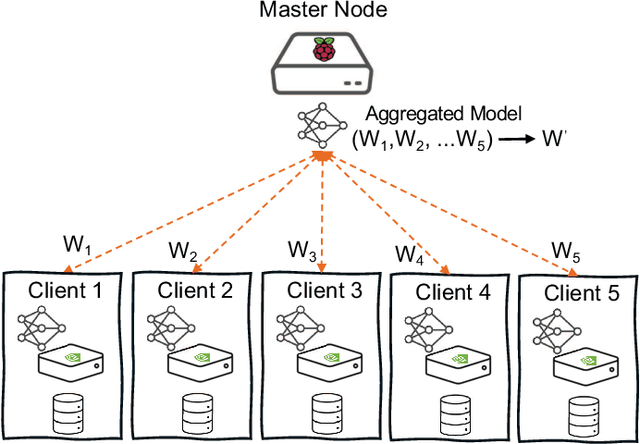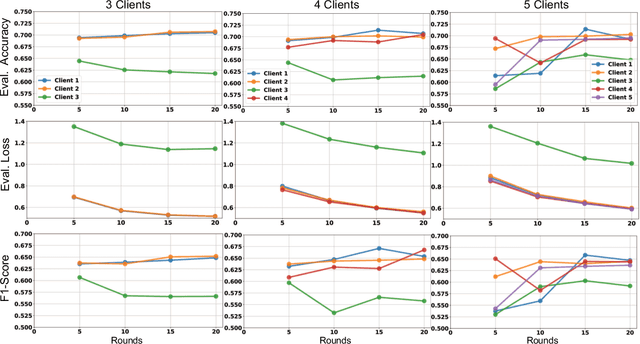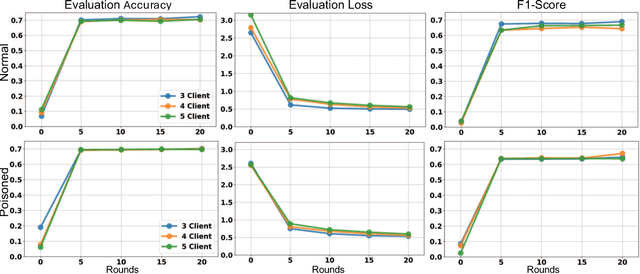Mizanur Rahman
Quantum-Classical Hybrid Framework for Zero-Day Time-Push GNSS Spoofing Detection
Aug 25, 2025Abstract:Global Navigation Satellite Systems (GNSS) are critical for Positioning, Navigation, and Timing (PNT) applications. However, GNSS are highly vulnerable to spoofing attacks, where adversaries transmit counterfeit signals to mislead receivers. Such attacks can lead to severe consequences, including misdirected navigation, compromised data integrity, and operational disruptions. Most existing spoofing detection methods depend on supervised learning techniques and struggle to detect novel, evolved, and unseen attacks. To overcome this limitation, we develop a zero-day spoofing detection method using a Hybrid Quantum-Classical Autoencoder (HQC-AE), trained solely on authentic GNSS signals without exposure to spoofed data. By leveraging features extracted during the tracking stage, our method enables proactive detection before PNT solutions are computed. We focus on spoofing detection in static GNSS receivers, which are particularly susceptible to time-push spoofing attacks, where attackers manipulate timing information to induce incorrect time computations at the receiver. We evaluate our model against different unseen time-push spoofing attack scenarios: simplistic, intermediate, and sophisticated. Our analysis demonstrates that the HQC-AE consistently outperforms its classical counterpart, traditional supervised learning-based models, and existing unsupervised learning-based methods in detecting zero-day, unseen GNSS time-push spoofing attacks, achieving an average detection accuracy of 97.71% with an average false negative rate of 0.62% (when an attack occurs but is not detected). For sophisticated spoofing attacks, the HQC-AE attains an accuracy of 98.23% with a false negative rate of 1.85%. These findings highlight the effectiveness of our method in proactively detecting zero-day GNSS time-push spoofing attacks across various stationary GNSS receiver platforms.
DashboardQA: Benchmarking Multimodal Agents for Question Answering on Interactive Dashboards
Aug 24, 2025Abstract:Dashboards are powerful visualization tools for data-driven decision-making, integrating multiple interactive views that allow users to explore, filter, and navigate data. Unlike static charts, dashboards support rich interactivity, which is essential for uncovering insights in real-world analytical workflows. However, existing question-answering benchmarks for data visualizations largely overlook this interactivity, focusing instead on static charts. This limitation severely constrains their ability to evaluate the capabilities of modern multimodal agents designed for GUI-based reasoning. To address this gap, we introduce DashboardQA, the first benchmark explicitly designed to assess how vision-language GUI agents comprehend and interact with real-world dashboards. The benchmark includes 112 interactive dashboards from Tableau Public and 405 question-answer pairs with interactive dashboards spanning five categories: multiple-choice, factoid, hypothetical, multi-dashboard, and conversational. By assessing a variety of leading closed- and open-source GUI agents, our analysis reveals their key limitations, particularly in grounding dashboard elements, planning interaction trajectories, and performing reasoning. Our findings indicate that interactive dashboard reasoning is a challenging task overall for all the VLMs evaluated. Even the top-performing agents struggle; for instance, the best agent based on Gemini-Pro-2.5 achieves only 38.69% accuracy, while the OpenAI CUA agent reaches just 22.69%, demonstrating the benchmark's significant difficulty. We release DashboardQA at https://github.com/vis-nlp/DashboardQA
Grid2Guide: A* Enabled Small Language Model for Indoor Navigation
Aug 11, 2025Abstract:Reliable indoor navigation remains a significant challenge in complex environments, particularly where external positioning signals and dedicated infrastructures are unavailable. This research presents Grid2Guide, a hybrid navigation framework that combines the A* search algorithm with a Small Language Model (SLM) to generate clear, human-readable route instructions. The framework first conducts a binary occupancy matrix from a given indoor map. Using this matrix, the A* algorithm computes the optimal path between origin and destination, producing concise textual navigation steps. These steps are then transformed into natural language instructions by the SLM, enhancing interpretability for end users. Experimental evaluations across various indoor scenarios demonstrate the method's effectiveness in producing accurate and timely navigation guidance. The results validate the proposed approach as a lightweight, infrastructure-free solution for real-time indoor navigation support.
Vision-Based Localization and LLM-based Navigation for Indoor Environments
Aug 11, 2025Abstract:Indoor navigation remains a complex challenge due to the absence of reliable GPS signals and the architectural intricacies of large enclosed environments. This study presents an indoor localization and navigation approach that integrates vision-based localization with large language model (LLM)-based navigation. The localization system utilizes a ResNet-50 convolutional neural network fine-tuned through a two-stage process to identify the user's position using smartphone camera input. To complement localization, the navigation module employs an LLM, guided by a carefully crafted system prompt, to interpret preprocessed floor plan images and generate step-by-step directions. Experimental evaluation was conducted in a realistic office corridor with repetitive features and limited visibility to test localization robustness. The model achieved high confidence and an accuracy of 96% across all tested waypoints, even under constrained viewing conditions and short-duration queries. Navigation tests using ChatGPT on real building floor maps yielded an average instruction accuracy of 75%, with observed limitations in zero-shot reasoning and inference time. This research demonstrates the potential for scalable, infrastructure-free indoor navigation using off-the-shelf cameras and publicly available floor plans, particularly in resource-constrained settings like hospitals, airports, and educational institutions.
Evolution of ReID: From Early Methods to LLM Integration
Jun 16, 2025Abstract:Person re-identification (ReID) has evolved from handcrafted feature-based methods to deep learning approaches and, more recently, to models incorporating large language models (LLMs). Early methods struggled with variations in lighting, pose, and viewpoint, but deep learning addressed these issues by learning robust visual features. Building on this, LLMs now enable ReID systems to integrate semantic and contextual information through natural language. This survey traces that full evolution and offers one of the first comprehensive reviews of ReID approaches that leverage LLMs, where textual descriptions are used as privileged information to improve visual matching. A key contribution is the use of dynamic, identity-specific prompts generated by GPT-4o, which enhance the alignment between images and text in vision-language ReID systems. Experimental results show that these descriptions improve accuracy, especially in complex or ambiguous cases. To support further research, we release a large set of GPT-4o-generated descriptions for standard ReID datasets. By bridging computer vision and natural language processing, this survey offers a unified perspective on the field's development and outlines key future directions such as better prompt design, cross-modal transfer learning, and real-world adaptability.
Retrieval Augmented Generation-based Large Language Models for Bridging Transportation Cybersecurity Legal Knowledge Gaps
May 23, 2025Abstract:As connected and automated transportation systems evolve, there is a growing need for federal and state authorities to revise existing laws and develop new statutes to address emerging cybersecurity and data privacy challenges. This study introduces a Retrieval-Augmented Generation (RAG) based Large Language Model (LLM) framework designed to support policymakers by extracting relevant legal content and generating accurate, inquiry-specific responses. The framework focuses on reducing hallucinations in LLMs by using a curated set of domain-specific questions to guide response generation. By incorporating retrieval mechanisms, the system enhances the factual grounding and specificity of its outputs. Our analysis shows that the proposed RAG-based LLM outperforms leading commercial LLMs across four evaluation metrics: AlignScore, ParaScore, BERTScore, and ROUGE, demonstrating its effectiveness in producing reliable and context-aware legal insights. This approach offers a scalable, AI-driven method for legislative analysis, supporting efforts to update legal frameworks in line with advancements in transportation technologies.
Judging the Judges: Can Large Vision-Language Models Fairly Evaluate Chart Comprehension and Reasoning?
May 13, 2025Abstract:Charts are ubiquitous as they help people understand and reason with data. Recently, various downstream tasks, such as chart question answering, chart2text, and fact-checking, have emerged. Large Vision-Language Models (LVLMs) show promise in tackling these tasks, but their evaluation is costly and time-consuming, limiting real-world deployment. While using LVLMs as judges to assess the chart comprehension capabilities of other LVLMs could streamline evaluation processes, challenges like proprietary datasets, restricted access to powerful models, and evaluation costs hinder their adoption in industrial settings. To this end, we present a comprehensive evaluation of 13 open-source LVLMs as judges for diverse chart comprehension and reasoning tasks. We design both pairwise and pointwise evaluation tasks covering criteria like factual correctness, informativeness, and relevancy. Additionally, we analyze LVLM judges based on format adherence, positional consistency, length bias, and instruction-following. We focus on cost-effective LVLMs (<10B parameters) suitable for both research and commercial use, following a standardized evaluation protocol and rubric to measure the LVLM judge's accuracy. Experimental results reveal notable variability: while some open LVLM judges achieve GPT-4-level evaluation performance (about 80% agreement with GPT-4 judgments), others struggle (below ~10% agreement). Our findings highlight that state-of-the-art open-source LVLMs can serve as cost-effective automatic evaluators for chart-related tasks, though biases such as positional preference and length bias persist.
ChartQAPro: A More Diverse and Challenging Benchmark for Chart Question Answering
Apr 10, 2025Abstract:Charts are ubiquitous, as people often use them to analyze data, answer questions, and discover critical insights. However, performing complex analytical tasks with charts requires significant perceptual and cognitive effort. Chart Question Answering (CQA) systems automate this process by enabling models to interpret and reason with visual representations of data. However, existing benchmarks like ChartQA lack real-world diversity and have recently shown performance saturation with modern large vision-language models (LVLMs). To address these limitations, we introduce ChartQAPro, a new benchmark that includes 1,341 charts from 157 diverse sources, spanning various chart types, including infographics and dashboards, and featuring 1,948 questions in various types, such as multiple-choice, conversational, hypothetical, and unanswerable questions, to better reflect real-world challenges. Our evaluations with 21 models show a substantial performance drop for LVLMs on ChartQAPro; e.g., Claude Sonnet 3.5 scores 90.5% on ChartQA but only 55.81% on ChartQAPro, underscoring the complexity of chart reasoning. We complement our findings with detailed error analyses and ablation studies, identifying key challenges and opportunities for advancing LVLMs in chart understanding and reasoning. We release ChartQAPro at https://github.com/vis-nlp/ChartQAPro.
Federated Learning in Adversarial Environments: Testbed Design and Poisoning Resilience in Cybersecurity
Sep 15, 2024



Abstract:This paper presents the design and implementation of a Federated Learning (FL) testbed, focusing on its application in cybersecurity and evaluating its resilience against poisoning attacks. Federated Learning allows multiple clients to collaboratively train a global model while keeping their data decentralized, addressing critical needs for data privacy and security, particularly in sensitive fields like cybersecurity. Our testbed, built using the Flower framework, facilitates experimentation with various FL frameworks, assessing their performance, scalability, and ease of integration. Through a case study on federated intrusion detection systems, we demonstrate the testbed's capabilities in detecting anomalies and securing critical infrastructure without exposing sensitive network data. Comprehensive poisoning tests, targeting both model and data integrity, evaluate the system's robustness under adversarial conditions. Our results show that while federated learning enhances data privacy and distributed learning, it remains vulnerable to poisoning attacks, which must be mitigated to ensure its reliability in real-world applications.
A Comprehensive Review of Recommender Systems: Transitioning from Theory to Practice
Jul 18, 2024



Abstract:Recommender Systems (RS) play an integral role in enhancing user experiences by providing personalized item suggestions. This survey reviews the progress in RS inclusively from 2017 to 2024, effectively connecting theoretical advances with practical applications. We explore the development from traditional RS techniques like content-based and collaborative filtering to advanced methods involving deep learning, graph-based models, reinforcement learning, and large language models. We also discuss specialized systems such as context-aware, review-based, and fairness-aware RS. The primary goal of this survey is to bridge theory with practice. It addresses challenges across various sectors, including e-commerce, healthcare, and finance, emphasizing the need for scalable, real-time, and trustworthy solutions. Through this survey, we promote stronger partnerships between academic research and industry practices. The insights offered by this survey aim to guide industry professionals in optimizing RS deployment and to inspire future research directions, especially in addressing emerging technological and societal trends
 Add to Chrome
Add to Chrome Add to Firefox
Add to Firefox Add to Edge
Add to Edge